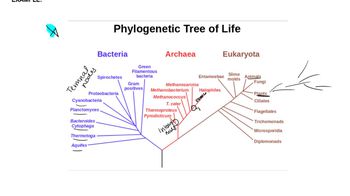Table of contents
- 1. Introduction to Genetics51m
- 2. Mendel's Laws of Inheritance3h 37m
- 3. Extensions to Mendelian Inheritance2h 41m
- 4. Genetic Mapping and Linkage2h 28m
- 5. Genetics of Bacteria and Viruses1h 21m
- 6. Chromosomal Variation1h 48m
- 7. DNA and Chromosome Structure56m
- 8. DNA Replication1h 10m
- 9. Mitosis and Meiosis1h 34m
- 10. Transcription1h 0m
- 11. Translation58m
- 12. Gene Regulation in Prokaryotes1h 19m
- 13. Gene Regulation in Eukaryotes44m
- 14. Genetic Control of Development44m
- 15. Genomes and Genomics1h 50m
- 16. Transposable Elements47m
- 17. Mutation, Repair, and Recombination1h 6m
- 18. Molecular Genetic Tools19m
- 19. Cancer Genetics29m
- 20. Quantitative Genetics1h 26m
- 21. Population Genetics50m
- 22. Evolutionary Genetics29m
22. Evolutionary Genetics
Phylogenetic Trees
Problem 7a
Textbook Question
Carl Linnaeus, the 18th-century botanist who laid the foundation for the modern system of taxonomic nomenclature, placed chimpanzees and humans in the same genus. Discuss the merits of this classification.
 Verified step by step guidance
Verified step by step guidance1
Consider the anatomical similarities between humans and chimpanzees, such as skeletal structure, opposable thumbs, and facial features.
Examine the genetic evidence, noting that humans and chimpanzees share approximately 98-99% of their DNA, indicating a close evolutionary relationship.
Discuss the evolutionary perspective, where both species share a common ancestor, which supports their placement in the same genus.
Evaluate the behavioral and cognitive similarities, including tool use, social structures, and communication abilities, which further justify their close taxonomic relationship.
Reflect on the implications of this classification for understanding human evolution and the broader context of primate evolution.
Recommended similar problem, with video answer:
 Verified Solution
Verified SolutionThis video solution was recommended by our tutors as helpful for the problem above
Video duration:
2mPlay a video:
Was this helpful?
Key Concepts
Here are the essential concepts you must grasp in order to answer the question correctly.
Taxonomy
Taxonomy is the science of classification of living organisms. It involves organizing species into hierarchical categories based on shared characteristics and evolutionary relationships. The system developed by Carl Linnaeus, known as binomial nomenclature, assigns each species a two-part Latin name, which helps in identifying and categorizing organisms systematically.
Phylogenetics
Phylogenetics is the study of evolutionary relationships among biological species based on genetic, morphological, or behavioral data. This field uses phylogenetic trees to illustrate how species are related through common ancestry. The classification of chimpanzees and humans in the same genus reflects their close evolutionary relationship, highlighting the importance of genetic similarities in taxonomy.
Recommended video:
Guided course

Phylogenetic Trees
Evolutionary Biology
Evolutionary biology examines the processes that drive the evolution of species over time, including natural selection, genetic drift, and mutation. Understanding these processes is crucial for evaluating taxonomic classifications, as they provide insight into how species adapt and diverge. The classification of humans and chimpanzees together underscores their shared ancestry and the evolutionary mechanisms that have shaped their development.
Recommended video:
Guided course

Overview

 8:16m
8:16mWatch next
Master Phylogenetic Trees with a bite sized video explanation from Kylia Goodner
Start learningRelated Videos
Related Practice

